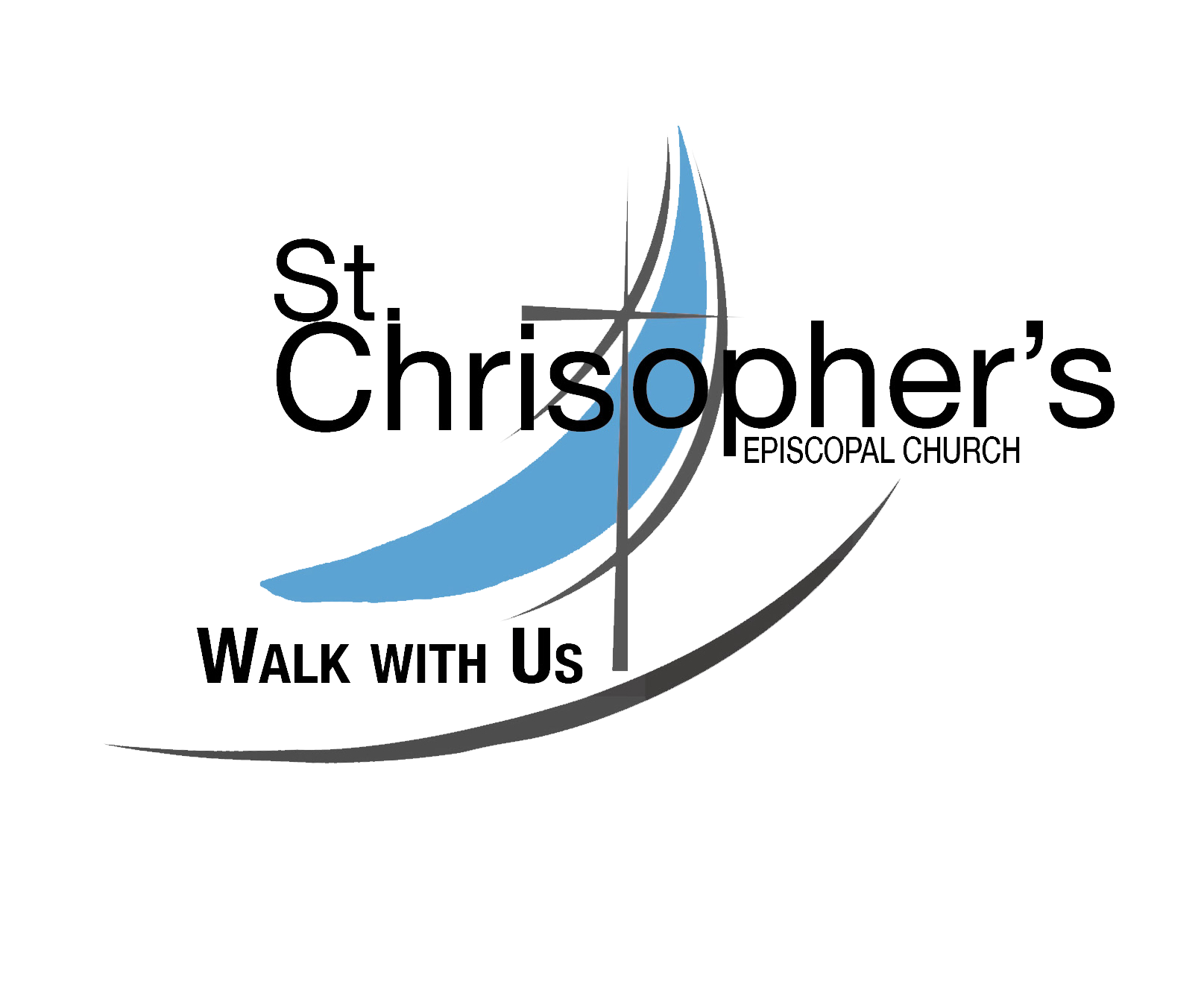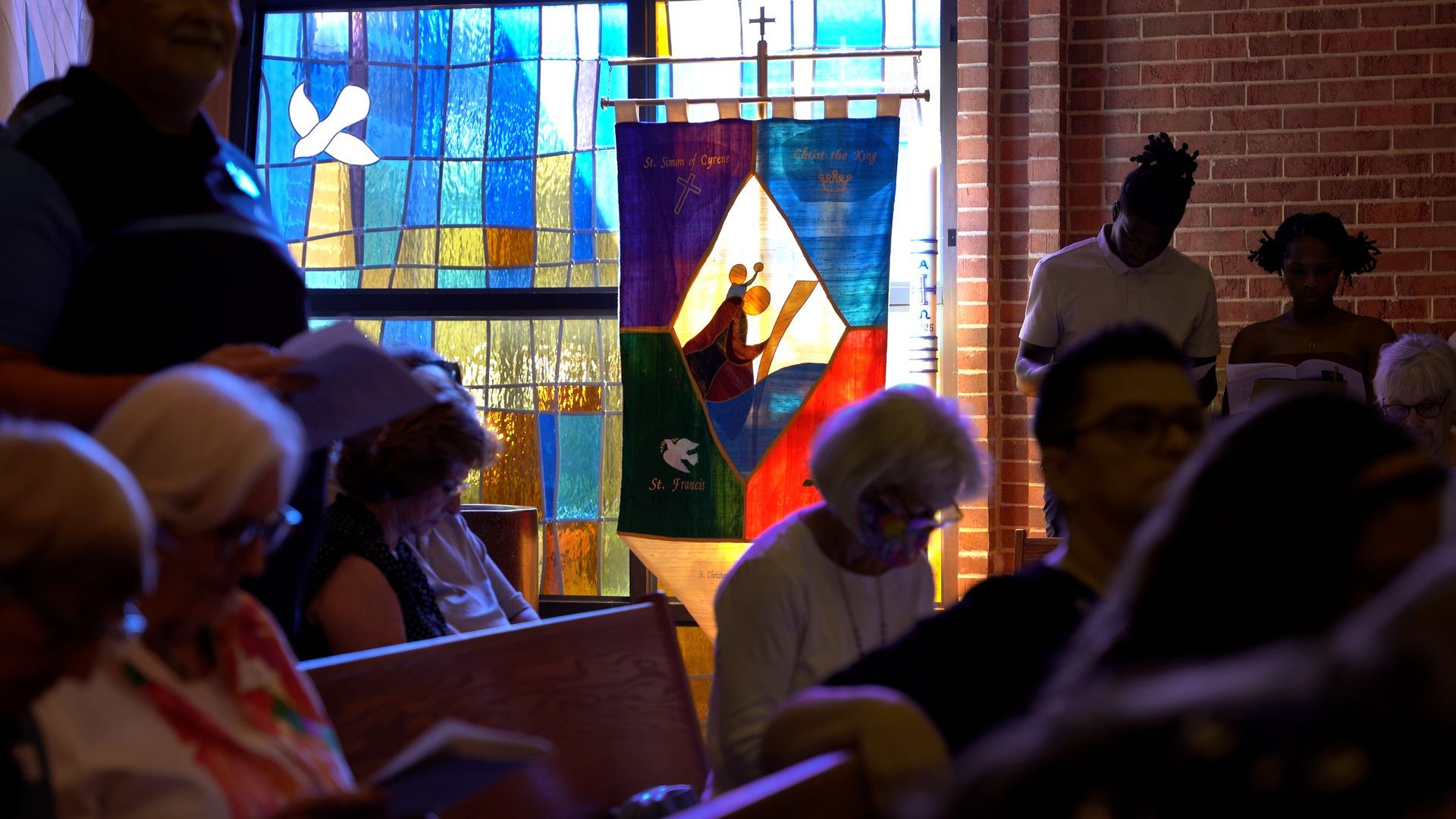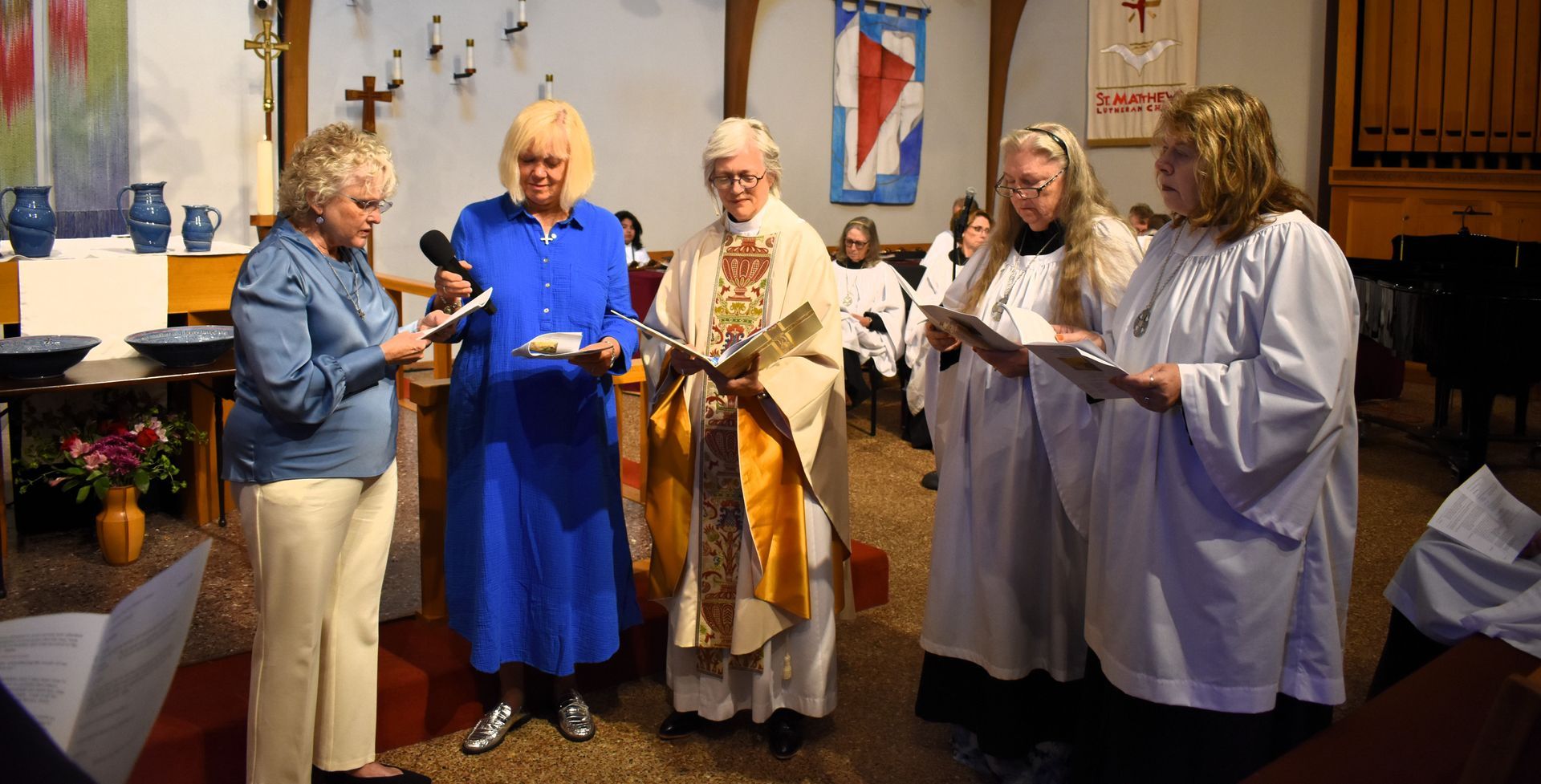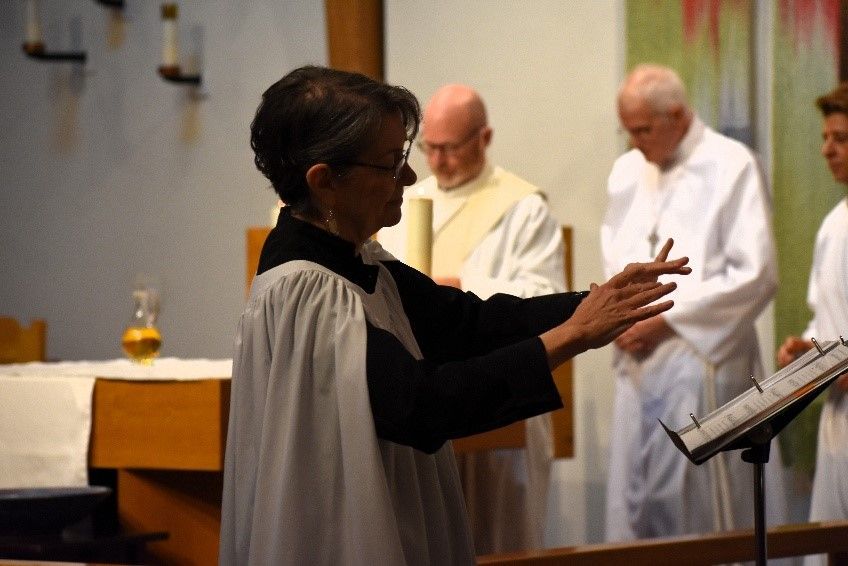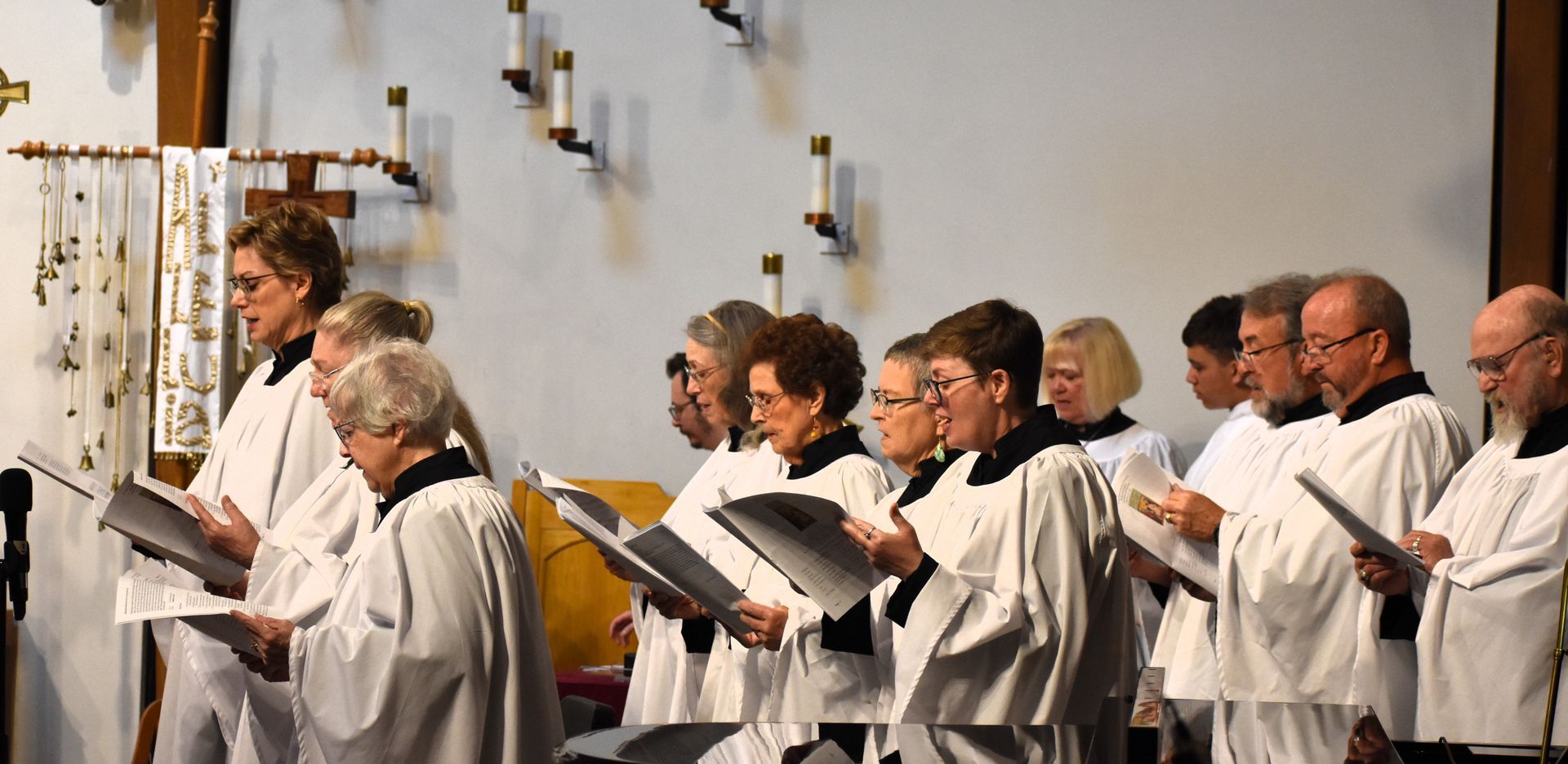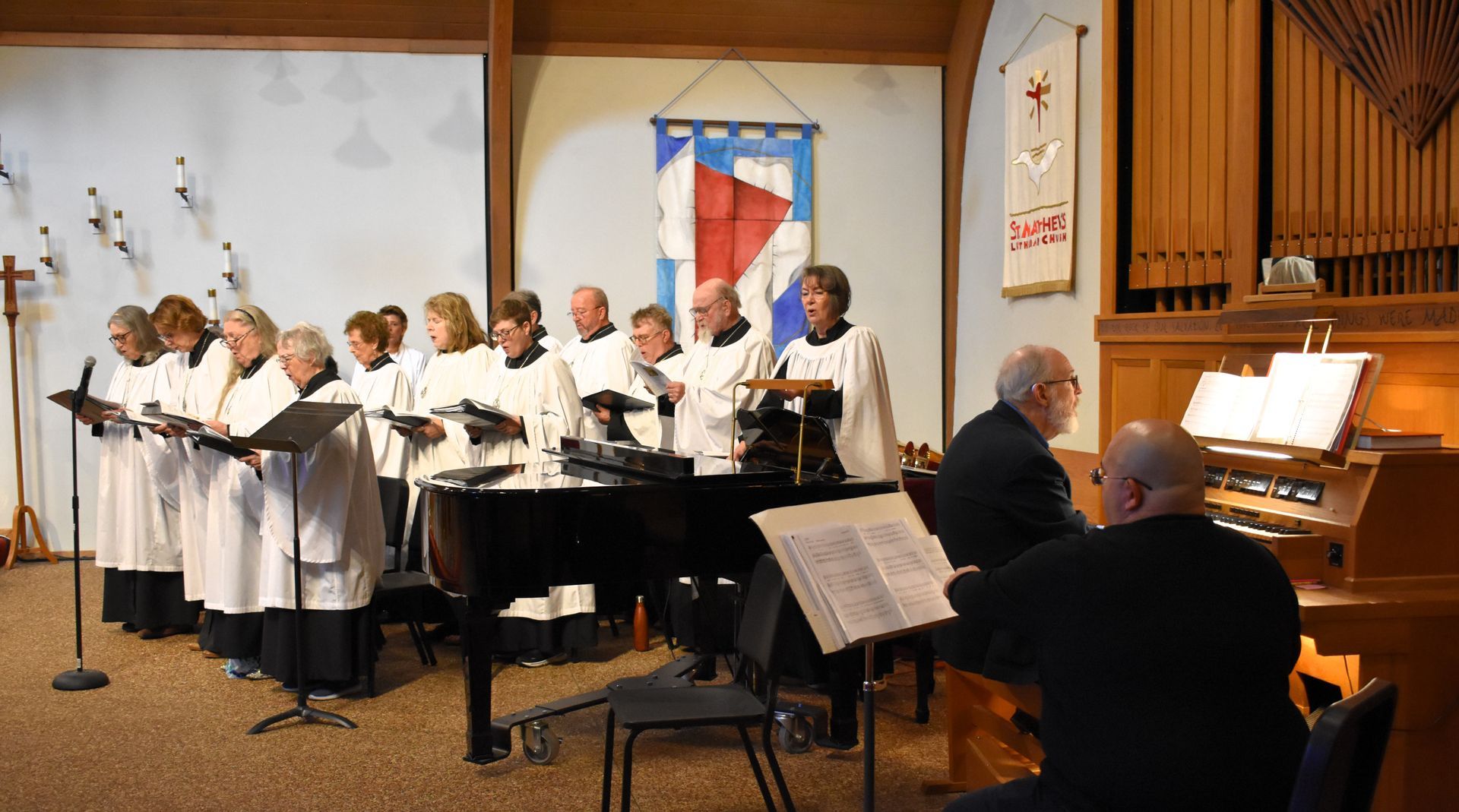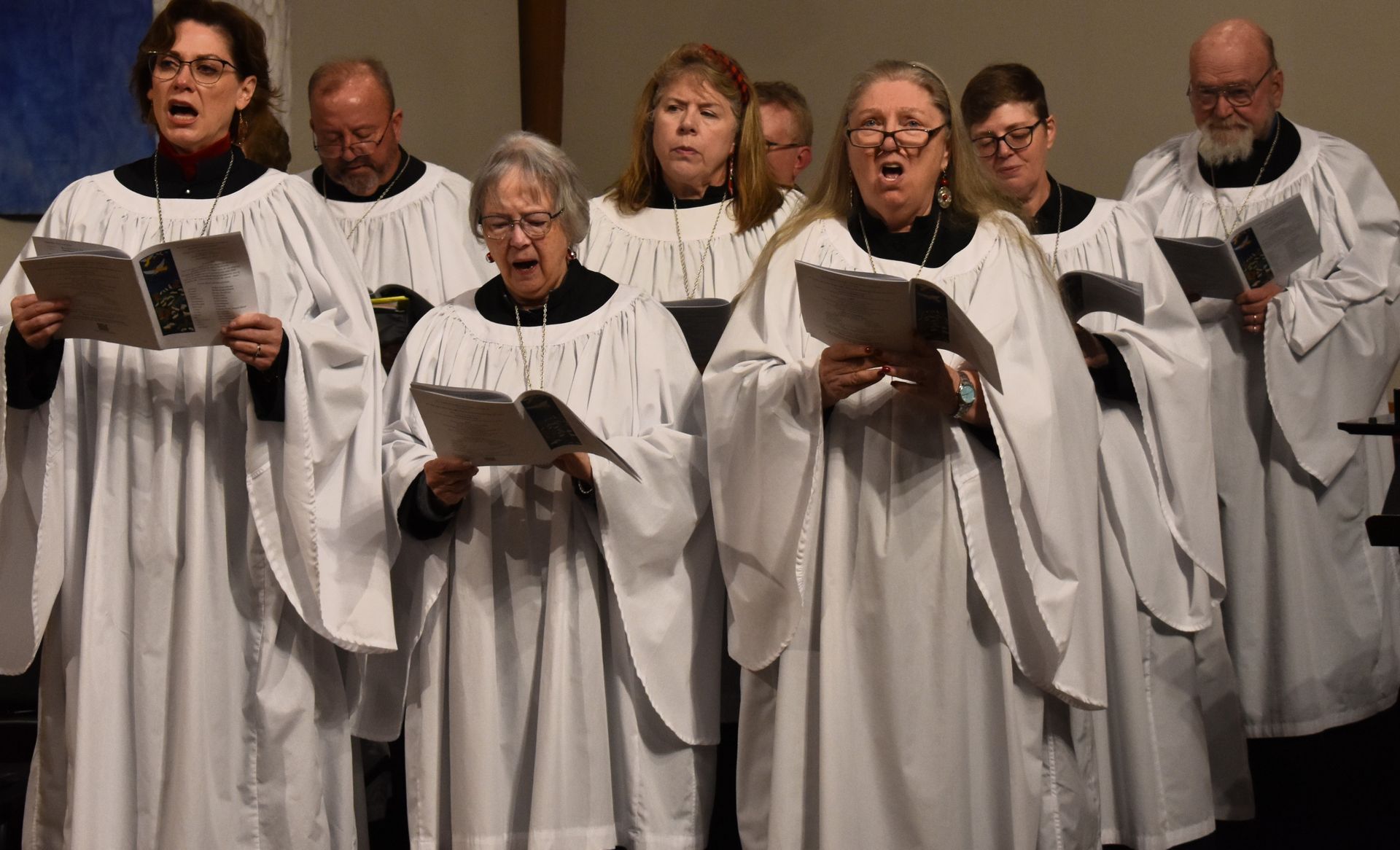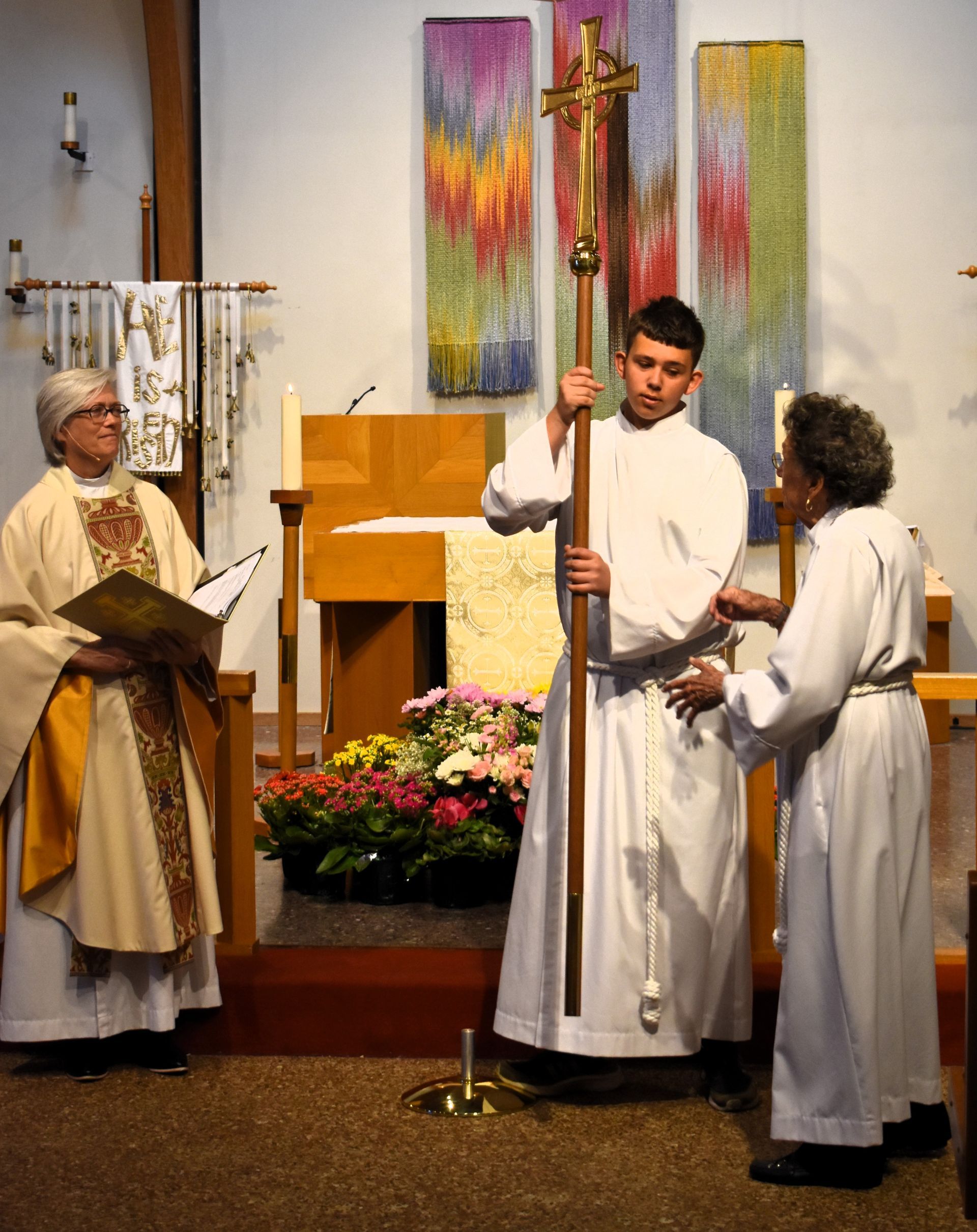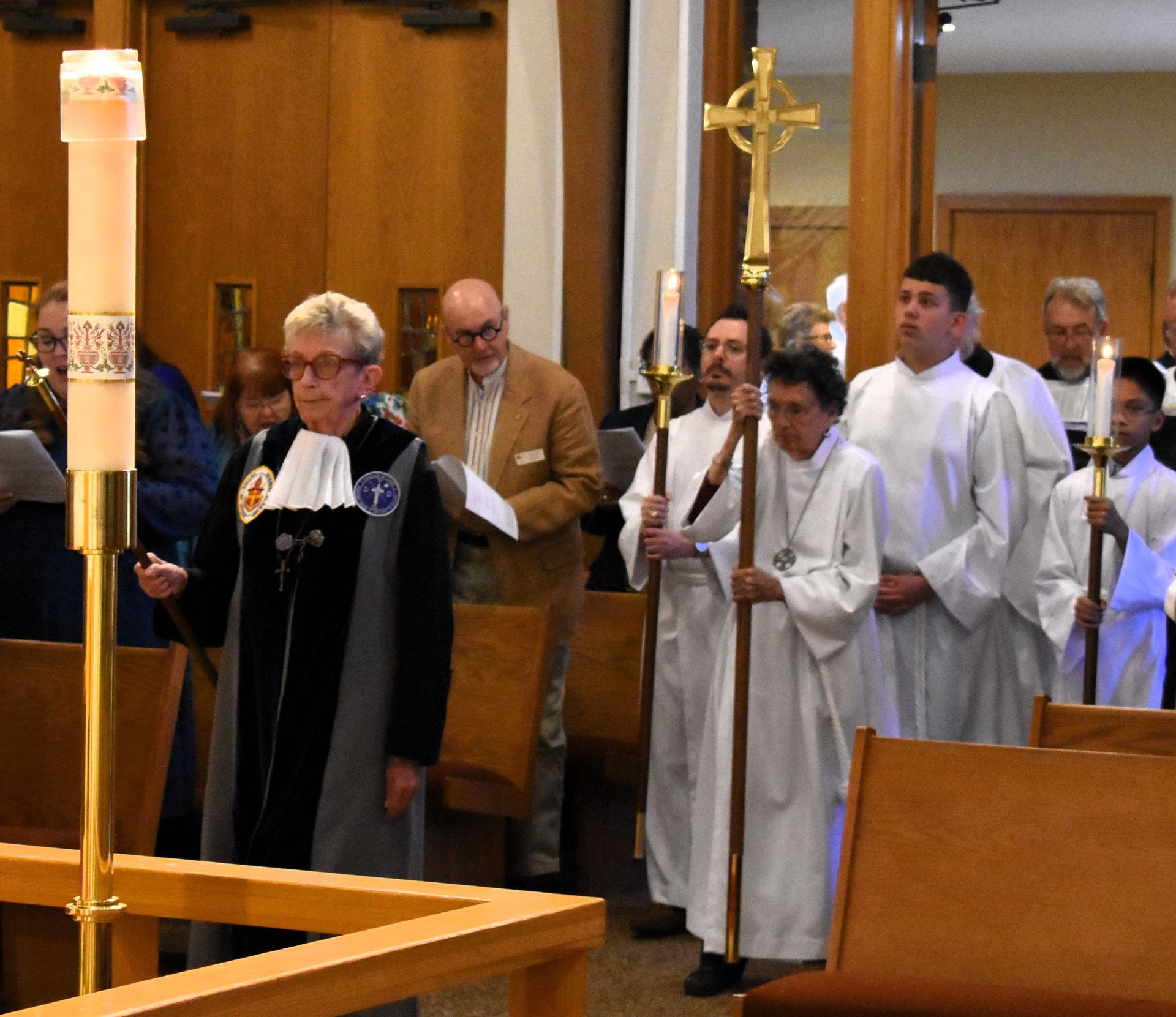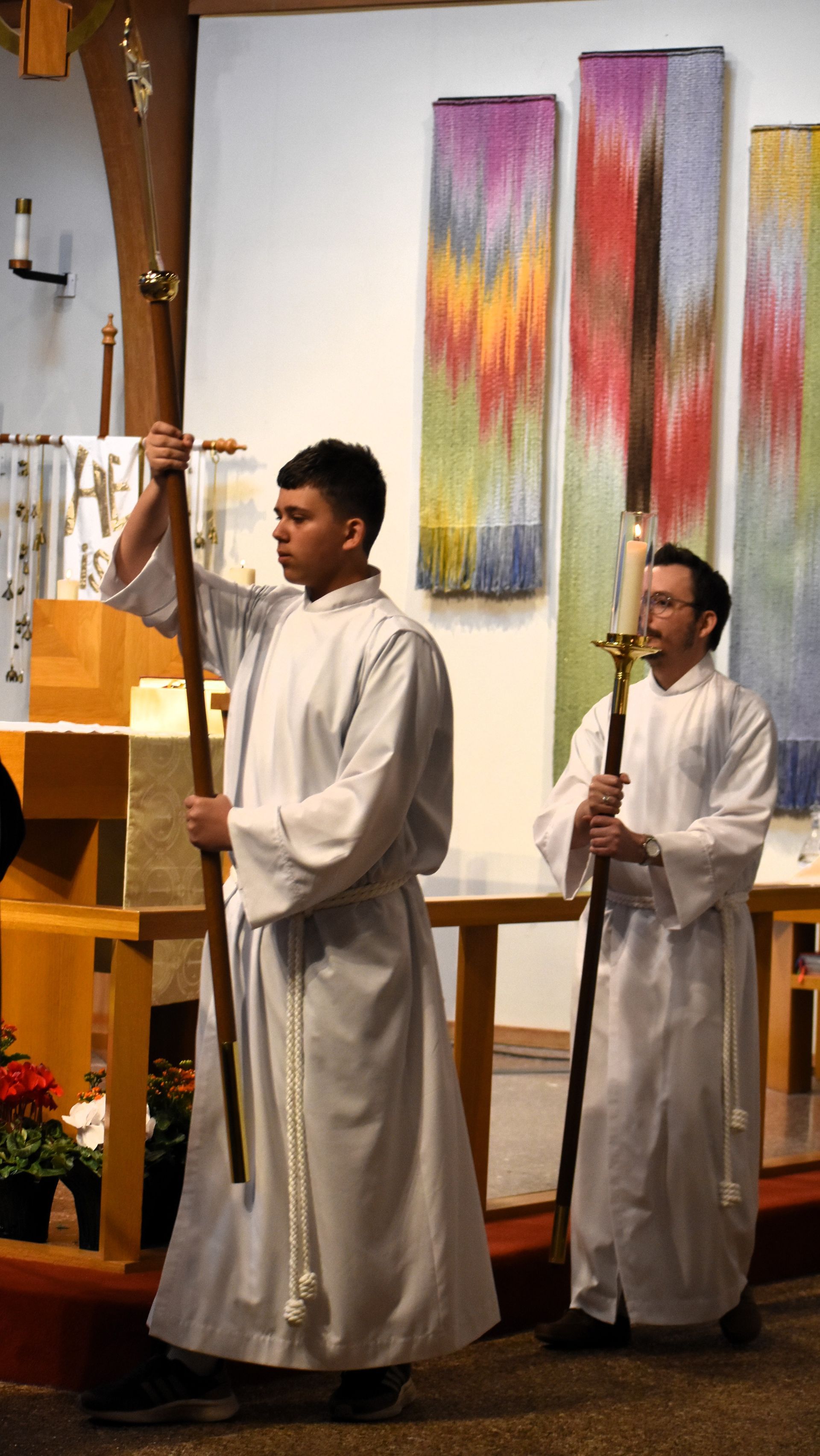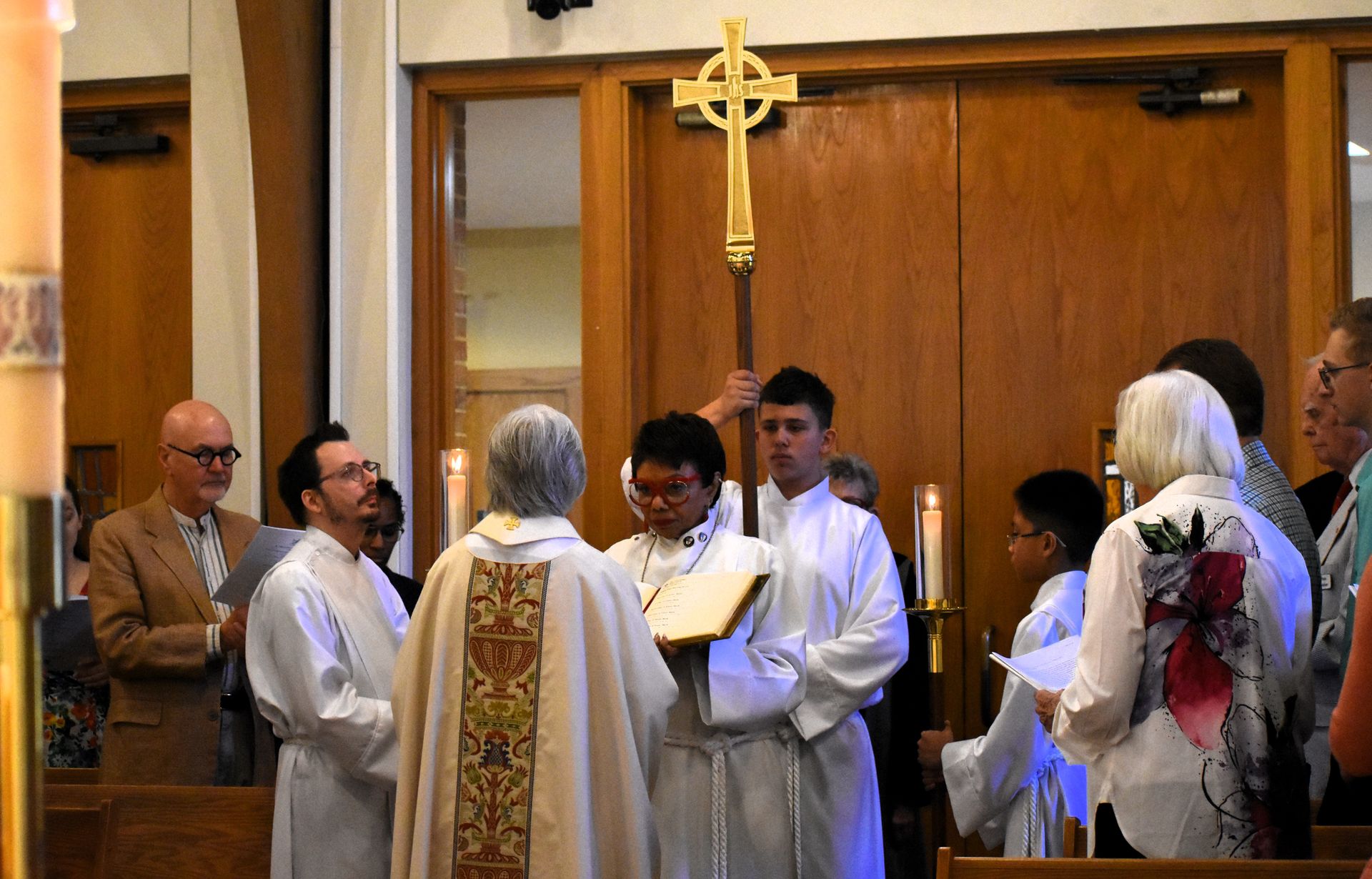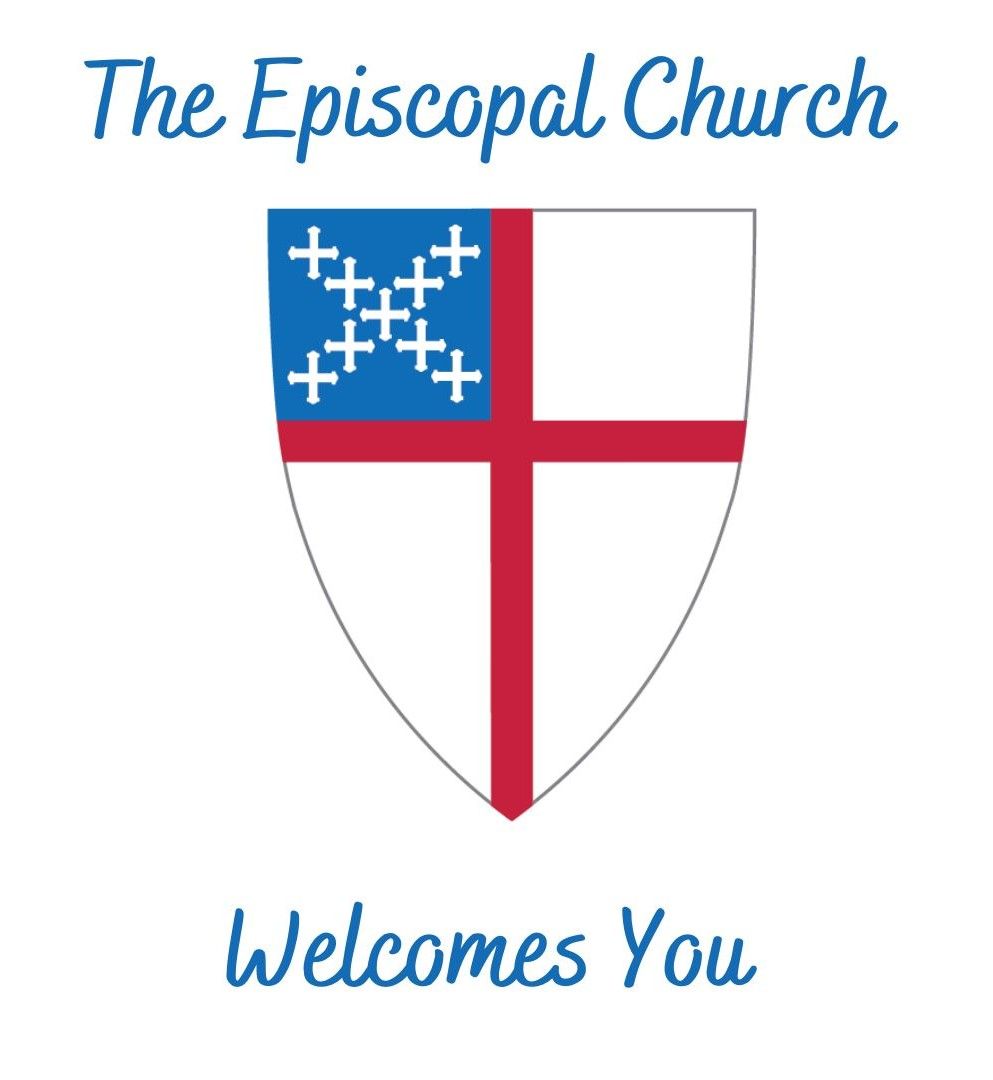Extra Extra
A Tapestry of Hope
St. Christopher’s new banner is not simply art — it is a story, stitched in silk. It tells of churches that lost their homes, of people who carried on in borrowed spaces, and of a church that has grown into something new, together.
A symbol of grace and welcome, the banner weaves together congregations once scattered, each with its own story of loss, survival and redemption.
“The meaning of the icons really tells a story of extraordinary hospitality and welcome,” said Jeanneane Keene, chair of the banner committee.
A Church Divided
The story behind the banner begins in 2008, when the Episcopal Diocese of Fort Worth fractured over disagreements about the ordination of women and same-sex marriage. The breakaway sparked a bitter legal battle that dragged on for more than a decade.
The split left deep wounds. Churches lost their buildings. Parishioners were displaced. Entire communities were forced to reckon with grief, dislocation and spiritual uncertainty.
But over time, many found their way to St. Christopher’s.
“It represents the welcome that St. Christopher provides,” said committee member Marti Fagley. “When we were hurting, when we were homeless, St. Christopher’s became a safe and welcoming place that helped us rebuild a new community.”
A Vicar’s Vision
The Rev. Paula Jefferson, the church’s vicar, said the idea for a new banner came during a diocesan council worship service. As she watched other congregations process proudly with their colorful banners, she felt a longing.
“I’ll confess — I wanted one of our own,” she said with a smile.
In August 2024, she formed a committee with representatives from each of the congregations that had joined to form St. Christopher’s.
“A banner felt like the perfect way to honor our journey, celebrate who we are today, and look forward to what’s ahead,” she said.
She turned to Keene to lead the project. At 91, Keene is the church’s oldest living original member, having joined just a week after its founding in 1957. She raised her family there, served multiple times as senior warden, and now acts as the church’s historian.
“Jeanneane brought everyone together,” said committee member Di Hall. “She was the moderator — making sure every voice was heard.”
Stitching Memory Into Fabric
The committee provided the vision, but the craft fell to Helen Ferguson, a longtime parishioner at All Saints’ Episcopal Church who had sewn vestments and
banners for years.
All Saints, too, had lost its building in the schism. Ferguson had to leave behind many of the banners she had created and even disinter her parents’ ashes from the church columbarium.
“That’s still hard,” she said.
When she first heard about the project, Ferguson thought it would be a simple, elegant piece. Instead, it became one of the most intricate works she had ever attempted.
Each congregation had to be represented. At the center, St. Christopher would carry the Christ child.
“It took a while to find what I thought might be appropriate depictions for each of the congregations,” Ferguson said. She agonized over details, backing each delicate silk piece so it wouldn’t fray, puzzling over how to depict St. Christopher and the Christ child.
“I would dream about it at night,” she admitted.
The final design included:
- A cross for St. Simon of Cyrene
- A crown for Christ the King
- A dove for St. Francis
- A rose for St. Elizabeth
The banner, made of Italian silk with embroidered lettering and symbols, consumed more than 100 hours of Ferguson’s labor.
“I think of it as e pluribus unum — out of many, one,” she said.
On the back, stitched in gold, is a quote from former Presiding Bishop Michael Curry: “If it’s not about love, it’s not about God.”
Ferguson is also looking forward with hope. All Saints recently purchased a building once occupied by a Methodist congregation. “I want a parish-wide demo day,” she said with a laugh. “After the last five years, I want to break something.”
Stories Behind the Symbols
Etta Atkinson was raised Baptist, but her faith journey shifted when she married her Episcopalian husband in 1981. That marriage brought her to St. Simon of Cyrene, a historically Black Episcopal congregation, where she found a spiritual home. At St. Simon’s, she served faithfully on the altar guild and as a gifted lector – a gift she brought with her to St. Christopher’s.
Another lifelong member of St. Simon’s was Edwardean Harris, who had worshipped there since she was 8 years old. When the diocese split, Harris and others were, as she put it, “clapped out” of the church they had called home for decades.
“It was painful,” she said. “But one door closes and another one opens.”
For a time, Harris and fellow parishioners worshipped independently before eventually being invited to join St. Christopher’s. Years earlier, artist Ferguson had created a banner for St. Simon—an image of the saint carrying the cross on his back. For Harris, it felt deeply fitting that Ferguson would also be the one to design the new banner for St. Christopher’s.
“St. Chris is home to me,” she said.
Diane Batterson was a longtime member of Christ the King, joining in 1976 and serving on the vestry, altar guild, and flower guild. In 2008, she arrived to arrange flowers and found a large “Stop” sign on the door, along with a notice that no one could enter without permission from a priest appointed by then-Bishop Jack Iker. “We were locked out,” she said.
Batterson cried for days but soon threw herself into rebuilding. Her congregation worshipped at a Lutheran church, using a makeshift altar. Later, she and her late husband joined St. Elizabeth, only to lose that building too in 2021 after the Texas Supreme Court’s ruling.
She eventually made her way to St. Christopher’s. “I probably won’t ever leave St. Chris—not unless they make me,” she said.
Marti Fagley and her husband relocated to North Texas in the early 2000s.
“When I found out where we were moving, I thought, ‘God, what have you got in mind for me?’” she said. With the brewing split already on the horizon, “I realized my job was to be the ‘no’ vote.”
They became active at St. Francis of Assisi in Willow Park, where Fagley served on the vestry and led the diocesan Daughters of the King. Even before the split, she sensed what was coming and drove to Wichita Falls with another member to prepare.
When St. Francis joined the breakaway diocese, she and others formed a new Episcopal congregation, worshipping in an elementary school with a portable altar her husband built. They eventually called a priest, but over time decided to disband.
By then, Fagley was leading an Education for Ministry group at St. Christopher’s. “I had a key to the building,” she said. “And I thought—why don’t we just go there?”
In 2021, when St. Christopher’s lost its building in the litigation, she was serving as senior warden and helped secure a temporary worship space at St. Matthew’s Lutheran Church, where the congregation still gathers.
Di Hall, raised Roman Catholic, came to St. Christopher’s in the late 1990s after someone left a “welcome to the neighborhood” pamphlet on her door. She sent her son to the pre-school and became active in parish life.
Though she left for a time to attend a Bible church, she eventually returned.
“I enjoyed the Bible church, but I missed communion weekly,” she said. “I missed the liturgy and the mass and everything. I missed being Episcopalian.”
For her, the banner represents “a group of people that didn’t really have a home — kind of like me.”
“St. Chris, it’s family,” she said. “It’s my heart.”
Today, the finished banner rests in the same stand once used by St. Simon of Cyrene’s banner — another thread in the tapestry of shared history.
For Jefferson, it stands as both memory and promise.
“It honors our journey,” she said, “but it also celebrates who we are today and who God is calling us to become.”
From Broken Clay to Sacred Vessels
The potter began her presentation sitting at her potter’s wheel, demonstrating how to make a bowl. Her hands skillfully shaped a beautiful vessel, turning the wheel as she perfected it. Then she completely destroyed it, pushing the beautiful shape into a mass of wet clay. The crowd gasped.
Rachel Norris, the potter, then talked about how God takes us and remolds us into what He desires for our lives. With that, she took the clay of the destroyed bowl and created a large and beautiful pitcher.
The captivated audience that day in 2023 included members of the Hildegard of Bingen chapter of the Daughters of the King who worship at St. Christopher’s Episcopal Church Fort Worth. They were at a Province VII meeting of the DOK in Shreveport, Louisiana. Norris was one of the presenters for the gathering.
“Suddenly we knew we wanted her to create the foot washing bowls and pitchers for our Holy Week service,” said Donna Clopton. St. Christopher lost its building and almost all other property such as altar goods in the wake of litigation that awarded the buildings and other property to people who left The Episcopal Church. They have nested in with St. Matthew’s Lutheran Church.
“We had already been talking because, first of all, when we had Maundy Thursday the first year without our church, we use plastic tubs for our foot washing. We didn't have anything. Then, last year, the second year, the Lutherans at St. Matthew's, said, "Well, you can use ours, that's fine." We did, but we just had it in the back of our minds, ‘Wouldn't it be nice to have our own set?’ Because gradually, we're trying to replace what we've lost, like our crèche and nativity sets, things that we lost.”
Why care about foot washing?
In John 13, we are told, “It was just before the Passover Festival. Jesus knew that the hour had come for him to leave this world and go to the Father. Having loved his own who were in the world, he loved them to the end. . .
12 When he had finished washing their feet, he put on his clothes and returned to his place. “Do you understand what I have done for you?” he asked them. 13 “You call me ‘Teacher’ and ‘Lord,’ and rightly so, for that is what I am. 14 Now that I, your Lord and Teacher, have washed your feet, you also should wash one another’s feet. 15 I have set you an example that you should do as I have done for you. 16 Very truly I tell you, no servant is greater than his master, nor is a messenger greater than the one who sent him.
34 “A new command I give you: Love one another. As I have loved you, so you must love one another.”
Jesus says repeatedly that they must serve one another just as he has done, including when it feels embarrassing. For the sake of Jesus’ love they must lower themselves in service to each other. They - we - must be willing to be uncomfortable, inconvenienced, and, yes, awkward in service to others.
So, this past summer Diane Hall, Gay Pogue, Frances Boase, and Donna Clopton made a trip to the studio of Potter Norris, who owns Joy Pottery of Bryan, Texas, four hours’ drive from Fort Worth. Read more at joypotterytx.com.
Norris spent four hours with the DOK group, discussing colors, design, and patterns. Clopton said Norris, a deeply spiritual person, understood the importance of Maundy Thursday in Holy Week and how and why the vessels would be used.
“I'm telling you, we didn't realize there were that many colors of blue. And she has so many different types of gorgeous pieces. . .and then the design, because she could do any pattern we wanted inside the bowl and the pictures. She was fully engaged with us,” Clopton said.
They discussed the weight of the pitchers, since people of all ages might be handling them during a service.
“We ordered two large pitchers to bring water from the sacristy and then two smaller pitchers that even a young child could probably handle” to pour water into the bowls, Clopton said.
A conference call with the Rev. Paula Jefferson and the Rev. Ron Pogue determined the right scripture to write across the large bowls.
“After choosing a blue color, a pattern, an imprint of the DOK cross and the scripture, we had a deal,” Clopton said.
The scripture read: Love one another as I have loved you. John15:12.
These items were delivered in September. They were presented to St. Christopher’s on All Saint’s Day, November 3rd, also celebrated as DOK day.
Clopton reflected on why the potter’s act of squishing a newly made perfect bowl into a mess of wet clay struck the women from St. Christopher’s so powerfully.
“We are a bunch of folks from a bunch of different congregations along with some folks who have never been in a church before. We're just like the potter and the clay,” Clopton said.
“It's still the same clay. God’s just created something new. These vessels acknowledge that.”
All through scripture, we are urged to sing. Of the more than 400 references to singing about 50 of them are direct commands. Singing is a powerful form of connection, and worship.
This is the story of how a new hymn of triumph, transformation, and thanksgiving has been born out of a tale of heartbreak and loss at St. Christopher Episcopal Church, Fort Worth.
Adam Wood, who wrote the words, and Shirley Johnson, who composed the music, are professional musicians. But this was more than just a commission to them. Both lived the experiences out of which the hymn arose.
The two of them brought their own experiences to the work of encapsulating and capturing the commonality of the loss, the grief, and then the joy of coming together to worship, to do ministry, and to reinvent all the things the congregation was doing before, now transformed into whole new things.
Science tells us singing changes our very bodies, and researchers have found that singing relieves stress and makes us feel both less anxious and more connected with each other. When the words we sing touch our own experiences, the impact can be powerful.
Bishop Gregory O. Brewer of Central Florida wrote, “Hymns and spiritual songs take our faith and compact it. . .”
That’s exactly what Summoned from what once was scattered, has done. The recent history of the diocese formerly known as Fort Worth has been compacted into four verses that tell a story of how loss, grief, and anger transformed disparate groups of homeless Episcopalians into a single loving community, committed to spreading news of God’s love to a hurting world.
St. Christopher's Episcopal Church, Fort Worth, was among the congregations that lost its building in 2021 following the decision of the US Supreme Court not to review the decision of the Texas Supreme Court to award more than $500 million worth of Episcopal Church property to people who chose to leave The Episcopal Church in 2008. Five other congregations also lost their buildings, joining the 14 others who lost buildings in the original split in 2008. St. Christopher soon began sharing worship space at St. Matthew’s Lutheran Church in Wedgwood in southwest Fort Worth. Its location near I-20 made it a convenient location for other Episcopalians needing a home. Soon St. Christopher, which had been joined by the congregation of the historically Black St. Simon of Cyrene in 2010, was joined by remnants from St. Elisabeth’s, Christ the King, and Parker County.
Shirley Johnson came to St. Christopher’s from Christ the King, which after losing its original building eventually nested in with St. Elisabeth’s. She was the choir master for both congregations. That joint congregation was disbanded after they lost their building, and several of them found St. Christopher. Shortly after that, St, Christopher’s rector retired, and the Rev. Paula Jefferson was called.
“So there we were, St. Christopher's people and [people from] several other churches,” Johnson said. “At some point she [the Rev. Paula Jefferson] began talking about commissioning a hymn that described and honored the journey that got us there and then the excitement of all of us being together. She knew I composed music because I've composed masses. She said, "Could you write a hymn?" I said, "Well, I've never written a hymn before and I definitely have to have the words before I can compose."
So Jefferson commissioned Adam Wood, a musician now living in California who had been living and worshiping in the diocese formerly known as Fort Worth during the 2008 schism. He worshiped at St. Stephen’s Hurst, which lost its building. He not only knew the history, but he had also lived through much of it.
The commissioning of the hymn marked a flex point for St. Christopher, adjusting to the retirement of their previous rector and the arrival of Jefferson as the new rector.
“It's a situation where, with all of us losing our buildings, a lot of us came together at St. Christopher, but we weren't really a church yet. Then Paula got here, and we began to move through some of the bitterness and anger and all the separateness. Before this, we were just all different congregations that ended up together. Then at some point, we started to thrive and move forward instead of living in the past,” Johnson said.
Johnson said that, even though she’s been a choir director and musician her whole life, she never thought of composing until the Christ the King building was lost. The strong emotions the situation evoked infused her with energy.
“When we got pushed out of that building, it's like all that energy had to go somewhere, and it came out in composing. That's when I ended up composing the masses that I've done. This just seems like a perfect part of the journey, that the bad things that happened are what spurred me to start composing. It's really been interesting,” she said.
As in most churches in the North Region, empowered laypeople at St. Christopher partner with their clergy to carry the message of God’s love to a hurting world.
Johnson, now choir director at St. Christopher, didn't know if she would ever again direct a choir. She feared losing her ministry as well as her building. Working on a hymn that celebrates St. Christopher discovering who it is in a whole new way helped Johnson find that for herself. Joy did come in the morning.
“We were bumping around for a while,” Johnson said. “Like, ‘Here we are. What are we?’ It did take a while to settle into anything that felt right.”
A mutual desire to create a welcoming loving space saved all these hurting people from devolving into bitterness. Just as Johnson created a hymn when she didn’t think she could, so too has this congregation been creating a healthy space in which love can grow.
Johnson laughed and said, “The honest part of that is, I really believed ‘I can't do this. I can't do this.’ Then, all of a sudden, you're just doing it.“It is thrilling when you hear the choir sing it. It's very thrilling. There's a strength about these people that is remarkable,” Johnson said.
“They deserved a hymn.”
Summoned from what once was scattered
1. Summoned from what once was scattered,
By your faithfulness preserve,
with new life here newly gathered
We proclaim what we have heard.
Guide us onward, guide us onward.
Make us bearers of your Word.
Make us bearers of your Word.
2. Dying to the past and living
into your bright morning dawn,
we are thriving and forgiving,
laying ground to build upon.
Guide us onward, guide us onward.
Walk with us as we go on.
Walk with us as we go on.
3. Here transformed in love and glory,
as on you we all are fed.
Fill our hearts, God, with your story,
as we share your wine and bread.
Guide us onward, guide us onward.
As we follow where you’ve led.
As we follow where you’ve led.
4. God who shares with us the journey,
on these people pour your grace.
We have pilgrimed this far, surely,
in the warmth of your embrace.
Guide us onward, guide us onward.
Seeking you in every place,
seeking you in every place.
New Cross, New Chapter
April 11, 2024
By: Tanya Eiserer
In April 2021, things were just starting to return to normal as the pandemic began to recede.
We’d returned to in-person worship on Easter. It was a joyous worship service tempered by the knowledge that it was to be one of the last times we would worship in that space.
St. Christopher’s, Fort Worth, found itself on the losing end of a contentious 12-year lawsuit in a diocese that broke up over women in the priesthood and gay marriage. Losing meant relinquishing our church building and many precious items contained within, including the brass processional cross that led us into worship for decades.
It’s been said the church is not the building; it’s the people in it.
We’d find out what it’s really like to live that maxim.
A Lutheran church welcomed us with open arms, exemplifying the true meaning of loving our neighbors as ourselves. As a parish, we had helped so many, now we found ourselves accepting help. Humbling to be sure. But freeing us from our old constraints.
We’ve grieved and agonized over that loss. While time doesn’t heal all wounds, it does help put them into perspective. Some of us even now believe the loss of the building may have been just what we needed. We’d been dying in place; we just hadn’t realized it.
In the last 18 months, we’ve welcomed the Rev. Paula Jefferson, an energetic priest who’s reinvigorated the church from top to bottom. We’ve seen new faces fill the pews. We’ve even got a kids’ section. What a concept. Parents and their kids now organically fill a side section of the sanctuary. Our Sunday adult Christian formation classes often fill to capacity. We’ve got a thriving group of career-age professionals who meet most Sundays to partake in a meal, fellowship, study and worship.
But sometimes, as human nature would have it, you still yearn for some of what you lost.
One of those things was that brass processional cross.
It meant something, particularly to our older members.
This past summer, we raised funds to celebrate our priest’s one-year anniversary. The family of Doris Gregory, one of our late parishioners, donated the funds to buy the new cross.
Doris led the altar guild for more than a decade. She’d been a stalwart member of St. Christopher’s. It seemed appropriate that it be donated in honor of someone who once brought her little grill to church to burn the prior year’s palm fronds to be used on Ash Wednesday.
Other members of the parish located the company that made the original processional cross. They agreed to forge a replica. It took eight months.
On Easter this year, the new processional cross led us into worship to the strains of “He is Risen.” The joyful words of that song ringing out into the sanctuary.
The cross made its debut in the hands of Jeanneane Keene. At 90, she could only lift the cross a few inches off the floor.
Jeanneane joined St. Christopher’s two weeks after the church’s founding in 1957. She is the last living member of that original group. She may have been among the first to carry that original cross, and now she’d be the first to carry it in a Sunday worship service.
It seemed fitting.
Walking just behind her in the procession was one of our younger acolytes –a strapping 12-year-old boy who looks 16 and happens to be my son.
He carried the new processional cross high during the gospel reading and as our priest baptized five children. In the act of baptism, we welcome new members into the body of Christ.
Just as it was fitting for Jeanneane to carry the cross in, it seemed fitting for the future of the church to carry the cross as our priest proclaimed the Gospel and baptized new Christians.
It was the symbolic passing of the torch, a reminder of the enduring power of the message of hope and salvation that we have as Christians.
While St. Christopher’s remains a people without a worship space to call our own, we know with absolute certainty that we are a people of resurrection. Hope will find a way.
The story was published on epicenter.org on April 11, 2024.
